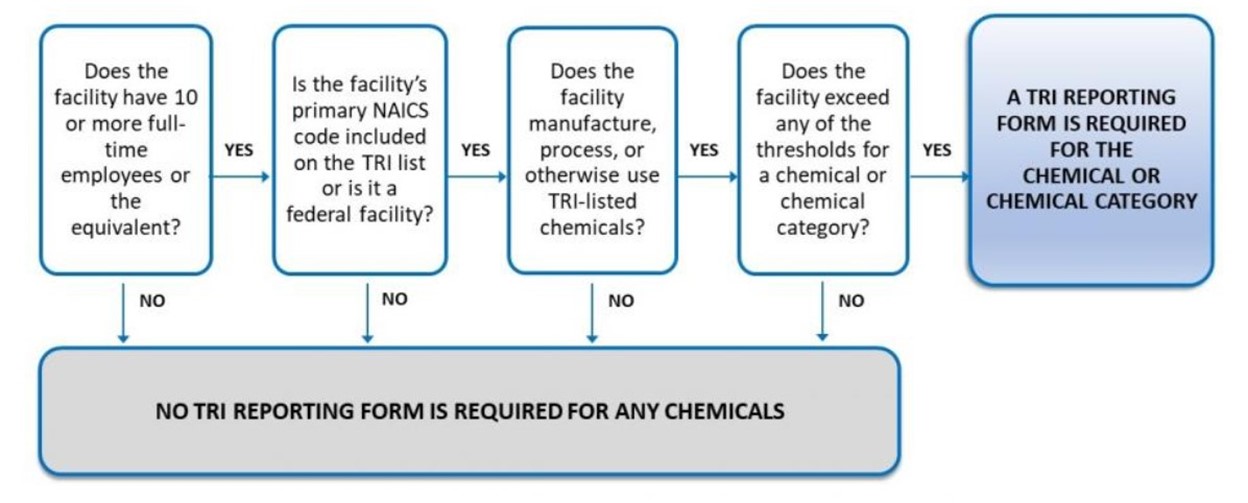The Toxic Release Inventory (TRI) reporting deadline is approaching on July 1, 2023.
If your facility needs to report, you need to be prepared now. TRI reporting can be tricky when you look behind the curtain. Below we cover some of the finer points of TRI reporting.
What is TRI Reporting?
TRI tracks the management of over 800 specified chemicals and chemical categories that may threaten human health and the environment. U.S. facilities in different industry sectors must report annually how much of each chemical is released to the environment and/or managed through recycling, energy recovery and treatment. A "release" of a chemical means it is emitted into the air or water or placed in some land disposal. This annual data is then used to produce the annual TRI Report, the TRI National Analysis.
Any facility that employs more than ten people and meets the requirements for TRI reporting is required under the Emergency Planning and Community Right to Know Act (EPCRA), Section 313, to submit an annual TRI report by July 1st to the USEPA and relevant TRI State Agency. The decision tree below by the USEPA can help facilities determine if they need to complete TRI reporting:

The Basics – TRI Chemical Reporting Thresholds
Generally, the threshold for reporting TRI chemicals that are manufactured or processed throughout the calendar year is 25,000 pounds. In comparison, the threshold for toxic chemicals that are “otherwise used” throughout the calendar year is 10,000 pounds. Manufacturing includes the production or import of a TRI-listed chemical. In contrast, processing includes using a TRI-listed chemical as a reactant, a formulation component, or an offer for recycling or reclamation. Common ‘otherwise uses’ of a TRI-listed chemical include as a manufacturing aid (e.g., refrigerants, hydraulic fluids) or an ancillary use such as for wastewater treatment. Consider this example for manufacturing/processing versus otherwise used:
- The use of certain solvents as a thinner or a cleaner in painting operations – when the solvent is used as a thinner, it is processed as part of the manufacturing process. In contrast, when used as a cleaner, it is “otherwise used” as an ancillary step to manufacturing.
The Tricky Part
Determining whether your facility meets the threshold for a TRI-listed chemical isn’t always straightforward. New toxic chemicals or chemical categories and new covered industry sectors can be added to TRI annually. Some chemicals are considered to be more toxic and have lower reporting thresholds. Reporting exemptions also exist and include exemptions for specific TRI-covered sectors, for TRI chemicals present in minor concentrations, and for some activities considered an “otherwise use,” such as motor vehicle maintenance. Below are some common areas in facilities that can get tripped up in reporting:
- The USEPA has identified chemicals of particular concern (CSC), including persistent bio-accumulative toxins (PBTs) with lower chemical-specific thresholds and ineligibility for some reporting exemptions. PBTs are highly toxic and long-lasting substances that can build up within the food chain and potentially harm human and overall ecosystem health. The TRI program has designated sixteen toxic chemicals and five chemical categories as PBTs. PBTs are typically pesticides, polynuclear aromatic hydrocarbons (PAHs), polychlorinated biphenyls (PCBs), lead and mercury, and are often found in burning, smelting and refining operations.
These materials have significantly lower reporting thresholds – 100 pounds or less. It’s important to review safety data sheets (SDSs) for these materials to determine if any of their components are TRI-listed chemicals and whether sufficient quantities of the material were processed, manufactured, or otherwise used throughout the calendar year to trigger reporting. An often missed substance is lead in lead solder or lead in aluminum – manufacturing, processing, or otherwise using more than 100 pounds in a calendar year triggers TRI reporting. - The USEPA employs several exemptions, including the de minimis exemption, which “allows covered facilities to disregard certain minimal concentrations of non-PBT chemicals in mixture or trade name products.” This exemption does not apply to the manufacture of a non-PBT chemical unless it is manufactured as an impurity and remains in the distributed product or it is imported below the corresponding de minimis. It also does not apply if a non-PBT chemical is manufactured coincidentally due to manufacturing, process, other use, or waste management activities.
To determine whether the exemption applies to a specific non-PBT chemical, the concentration of the chemical in mixtures and trade-name products must be assessed. If found to be below the appropriate de minimis level, all releases and other waste management activities associated with the chemical are exempt from EPCRA Section 313 reporting. As can be seen in the USEPA’s common questions and answers regarding specific incidents, there are many circumstances in which a facility might believe they qualify for the de minimis exemption when they do not. For example, suppose a mixture contains several xylene isomers that individually are below the de minimis threshold but exceed the reporting threshold as an aggregate. In that case, the facility should report the mixture as xylenes (mixed isomers). - Another exemption employed by USEPA is the article exemption. An article is a manufactured item: (1) Which is formed to a specific shape or design during manufacture; (2) which has end-use functions dependent in whole or in part upon its shape or design during end use; and (3) which does not release a toxic chemical under normal conditions of processing or use of that item at the facility or establishments. The article exemption states that if a TRI chemical is present in an article, the facility is not required to consider the amount of TRI chemicals when calculating reporting quantities of TRI-listed chemicals. An essential aspect of the article exemption is what constitutes a release of a toxic chemical. Any processing or otherwise use of an article that results in a release negates the exemption. Cutting, grinding, melting, or other processing of a manufactured item could result in a release of a toxic chemical during normal conditions of processing or otherwise use and, therefore, negate the exemption as an article.
- The newest chemicals on the rise, PFAS were included in Section 7321 of the National Defense Authorization Act (NDAA) for Fiscal Year 2020 and added to the list of TRI chemicals in 2020. PFAS includes a variety of man-made chemicals often found in food packaging, commercial household products such as stain-repellent fabrics, polishes, waxes, and cleaning products, production facility material such as chrome plating or electronics manufacturing, drinking water associated with a specific manufacturer, or wastewater treatment, as well as living organisms that contain PFAS from build-up over time. The reporting threshold for PFAS is 100 pounds.
Given these particularly low thresholds, facilities must review individual SDSs for per- and poly-fluoro isomers and determine if such materials exceed the de minimis concentrations and reporting thresholds.
.jpg?width=427&height=285&name=shutterstock_1707608446%20(1).jpg)
Putting It All Together
While TRI reporting may seem daunting, facilities with good insight into how much of each TRI-listed chemical is used in facility production, waste management activities, energy recovery and recycling, pollution prevention activities, and environmental releases can more easily navigate the trickier parts of TRI reporting. Thoroughly understanding and documenting a facility’s overall process flow, chemical usage, and production and waste activities will facilitate a more thorough and efficient reporting process whereby the potential pitfalls above can be avoided.
References
Toxics Release Inventory (TRI) Program
Addition of Certain PFAS to the TRI by the National Defense Authorization Act




